Overview
This article sheds light on the various sensory issues that children with autism face, presenting ten specific examples and exploring their impacts. Understanding these sensory challenges is vital for caregivers, as it enables them to develop effective strategies that create supportive environments. By doing so, they can significantly enhance the well-being and development of children with autism. We invite you to explore these insights and consider how you might implement supportive practices in your own life.
Introduction
Understanding sensory issues is essential for supporting children with autism, as these challenges can profoundly impact their daily lives and interactions. With as many as 90% of individuals on the autism spectrum experiencing sensory sensitivities, caregivers face the important task of recognizing and addressing these unique needs.
But how can families and educators create environments that not only accommodate but also empower these children to thrive amidst sensory overload? This article delves into ten compelling examples of sensory issues in children with autism, offering insights and strategies to help foster a more supportive and understanding atmosphere.
About ASD Media: Resources for Understanding Sensory Issues in Autism
At ASD Media, we are dedicated to enhancing the application of ABA therapy by providing a variety of resources specifically designed to address examples of sensory issues faced by children with developmental conditions. Did you know that recent studies indicate that up to 90% of individuals with autism spectrum disorder (ASD) show examples of sensory issues, including heightened sensitivity? This sensitivity can significantly impact their participation in school activities and their overall growth.
To support parents and professionals in navigating these complexities, ASD Media offers a wealth of articles, guides, and community assistance. By fostering a deeper understanding of sensory challenges, we empower caregivers to develop effective strategies that not only aid in their child's development but also enhance their overall well-being. Understanding examples of sensory issues is crucial, as these examples can lead to maladaptive behaviors and hinder academic performance.
Our resources aim to equip caregivers with the essential information needed to create supportive environments tailored to the unique needs of each child. Ultimately, we strive to foster success in various situations, ensuring that every young person has the opportunity to thrive. We invite you to explore our resources and share your experiences, as together we can make a positive impact on the lives of children with ASD.
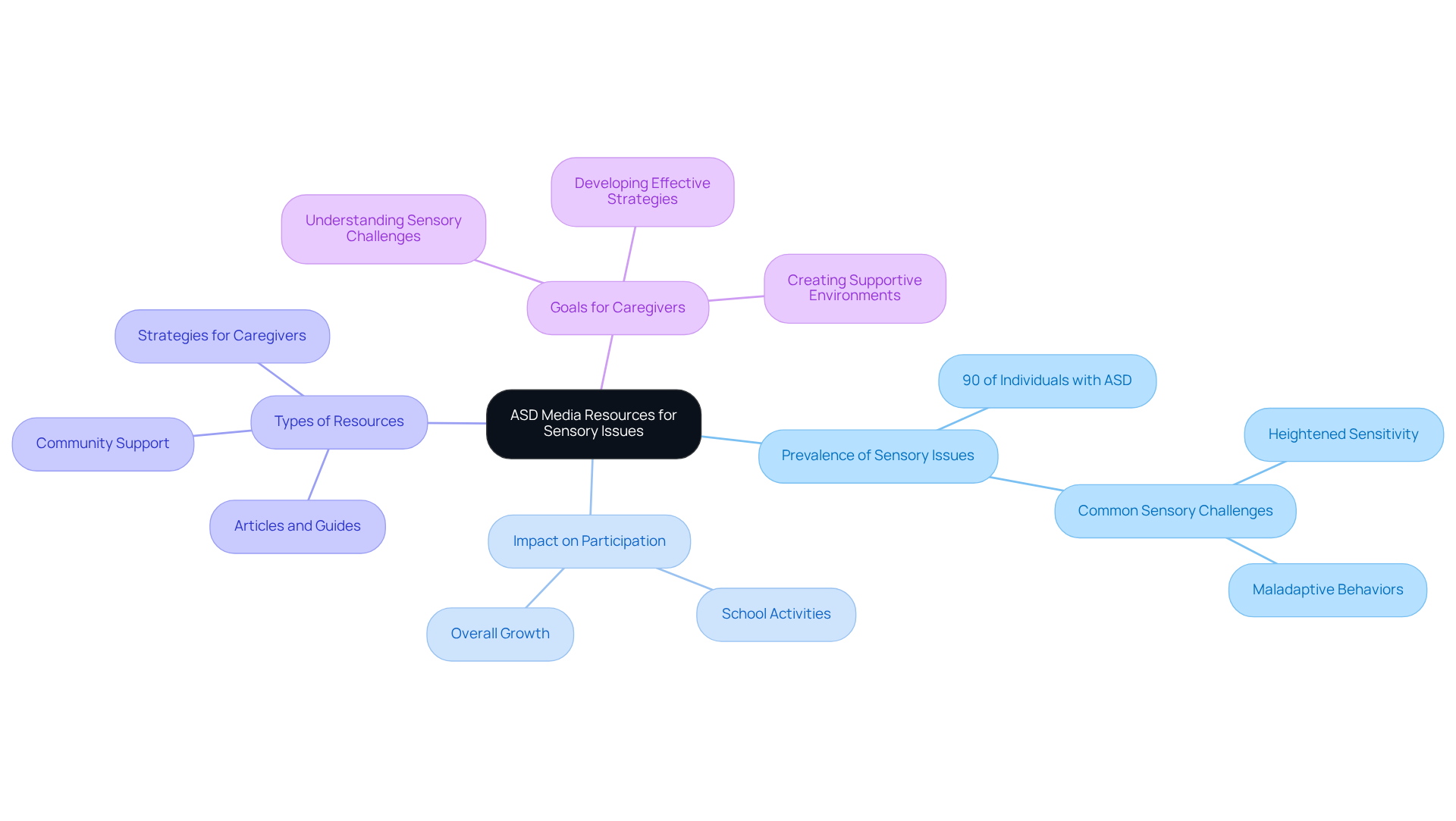
Auditory Sensitivity: Challenges with Noise and Sound
Auditory awareness presents a significant challenge for many children with autism, often resulting in discomfort or distress in loud environments. It's estimated that around 90% of autistic individuals experience some examples of sensory issues, particularly with sound awareness being notably common. Furthermore, approximately 70% of autistic individuals will show signs of sound sensitivity at various points in their lives. Children may respond intensely to loud noises, such as sirens or the commotion of crowded places, which can lead to increased anxiety or meltdowns.
To effectively support these children, caregivers can implement several nurturing strategies:
- Create Quieter Spaces: Establishing designated quiet areas at home and school allows children to retreat when overwhelmed by noise, helping them regain composure. Incorporating soundproofing materials like curtains, carpets, and acoustic panels can enhance these calming environments.
- Use Noise-Canceling Headphones: These headphones can filter out background noise, making busy environments more manageable and reducing the likelihood of sensory overload.
- Gradual Exposure: Introducing children to various sounds in a controlled manner can help desensitize their responses over time, easing their anxiety in louder settings.
- Structured Routines: Reliable daily patterns can improve predictability, assisting children in feeling more secure and prepared for potentially overwhelming situations.
- Mindful Techniques: Practicing deep breathing exercises can help children maintain calmness when confronted with distressing sounds. Additionally, distractions like doodling or using comforting toys can help manage auditory triggers.
Psychologists emphasize the importance of recognizing and addressing a young person’s perceptual needs, including examples of sensory issues, as these challenges can affect the entire family dynamic. As psychologist Amy Miko notes, "sensory challenges can influence the entire family of an autistic individual." By fostering an inclusive atmosphere and collaborating with experts, caregivers can significantly improve the quality of life for children with auditory sensitivities. Moreover, educating families about processing variations is crucial for creating supportive environments. It's also vital to recognize that some autistic individuals may be undersensitive to sensory inputs and might actively seek out these experiences.
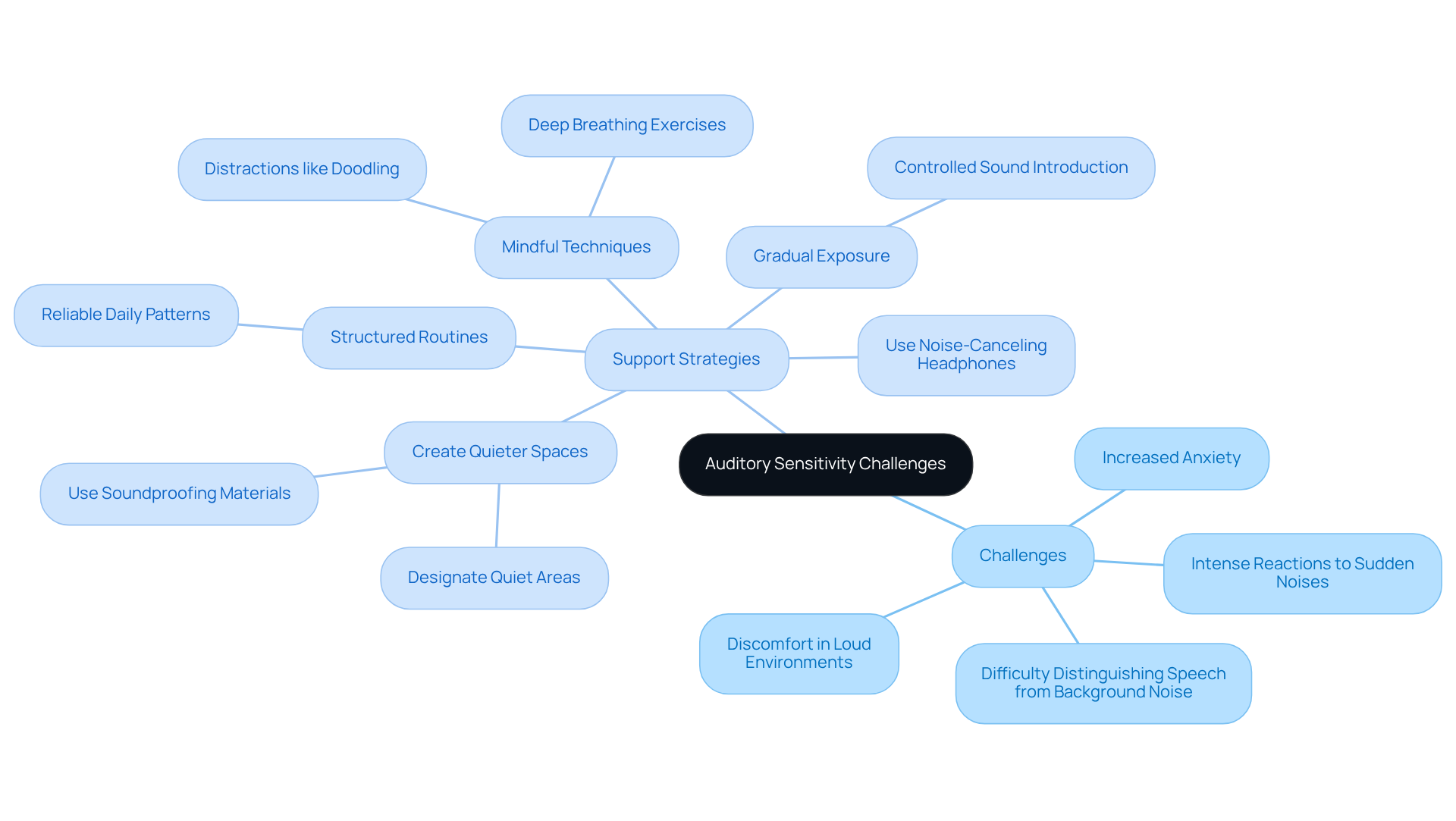
Visual Overstimulation: Effects of Bright Lights and Patterns
Visual overstimulation can be a challenging experience for young individuals with sensory sensitivities. When they encounter bright lights, intricate patterns, or rapid movements, it can lead to difficulties in concentration and increased anxiety. It's important to recognize that studies indicate up to 70% of youngsters with developmental disorders face examples of sensory issues. This highlights the need for effective strategies to manage visual overstimulation in their environments.
Caregivers can play a crucial role in this process. By implementing soft lighting and selecting simple, calming visuals, they can create a more soothing atmosphere for their children. Additionally, offering sunglasses or tinted lenses can be particularly beneficial when youngsters are outside or in well-lit areas, helping them manage their visual sensitivities more effectively.
Recent research, including the case study on 'Understanding Sensory Overload,' underscores the significance of these strategies in fostering a comfortable and supportive environment for individuals on the autism spectrum. As Steven Zauderer, CEO of CrossRiverTherapy, wisely notes, 'There are many examples of sensory issues that are a frequent challenge for kids with developmental disorders, but numerous strategies can be implemented by parents and caregivers to assist their offspring in evading sensory overload.'
Understanding the distinctions between autistic and non-autistic brains can further illuminate why individuals on the spectrum experience visual overstimulation differently. This knowledge can ultimately enhance their overall well-being. By taking proactive steps and embracing these strategies, we can help create a more nurturing environment for our children, allowing them to thrive despite their sensory challenges.
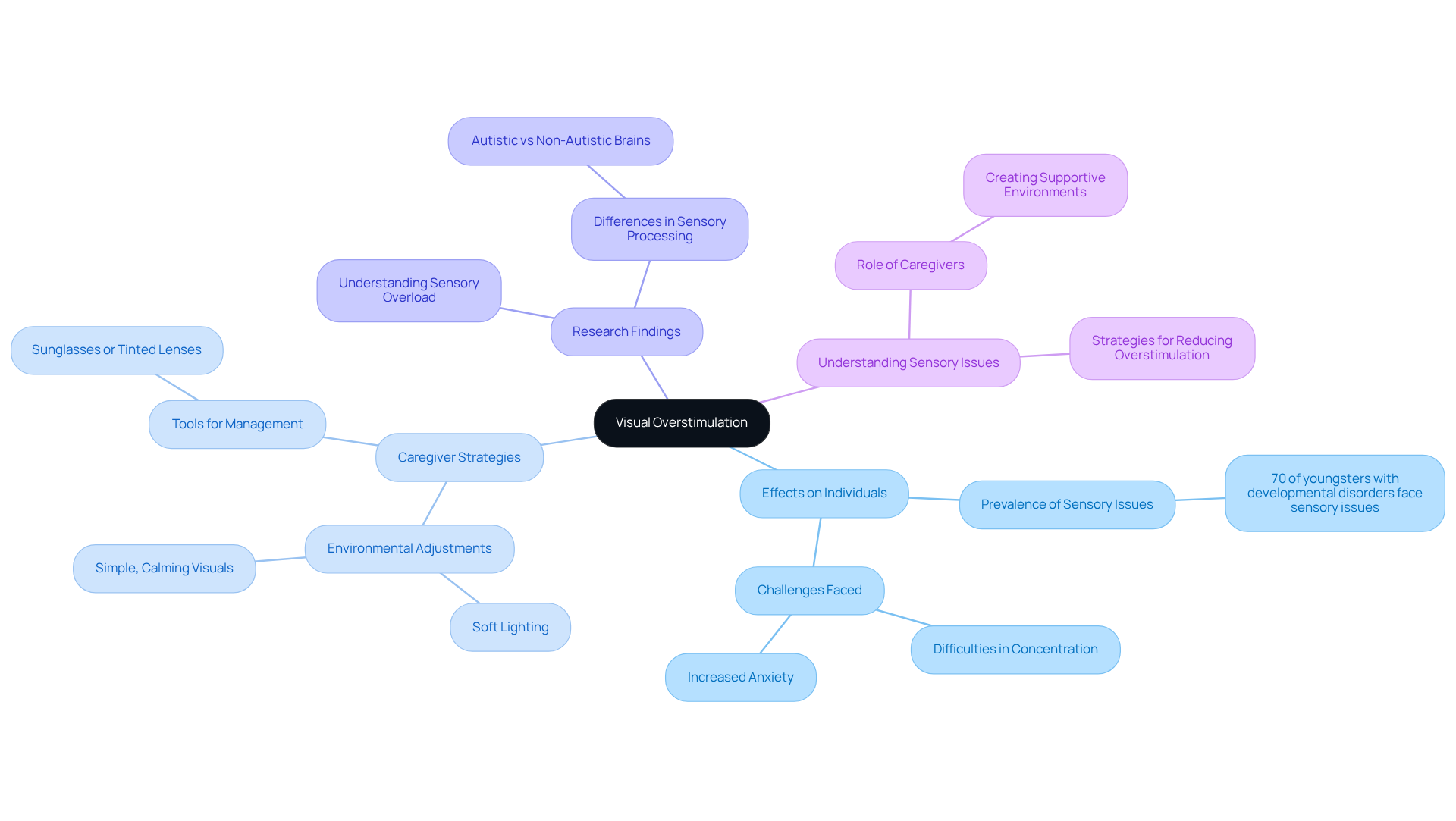
Tactile Sensitivity: Discomfort with Textures and Touch
Tactile awareness in individuals with autism can lead to challenging responses to certain fabrics, textures, or physical interactions. This heightened sensitivity often results in avoiding specific clothing items or experiencing discomfort during activities like play. Research indicates that over 96% of children with Autism Spectrum Disorders demonstrate examples of sensory issues, with touch being a common trigger. To support these children, caregivers can take several nurturing steps:
- Gradually introduce a variety of textures, allowing them to explore and adapt to different sensations at their own pace.
- Choose soft, tagless clothing to enhance their comfort.
- Provide sensory-friendly toys that align with their tactile preferences.
- Create a sensory-friendly environment by minimizing overwhelming stimuli and incorporating calming elements.
As Dr. Shinichi Suzuki wisely notes, 'Every individual, with or without disabilities, must work to achieve their best.' This highlights the importance of personalized approaches in fostering comfort and acceptance for young ones navigating tactile discomfort. Moreover, sensory integration specialists emphasize that understanding examples of sensory issues, including each child's unique reactions to textures, can lead to more effective support strategies. By embracing these practices, we can create a more supportive environment for our children, encouraging their growth and well-being.
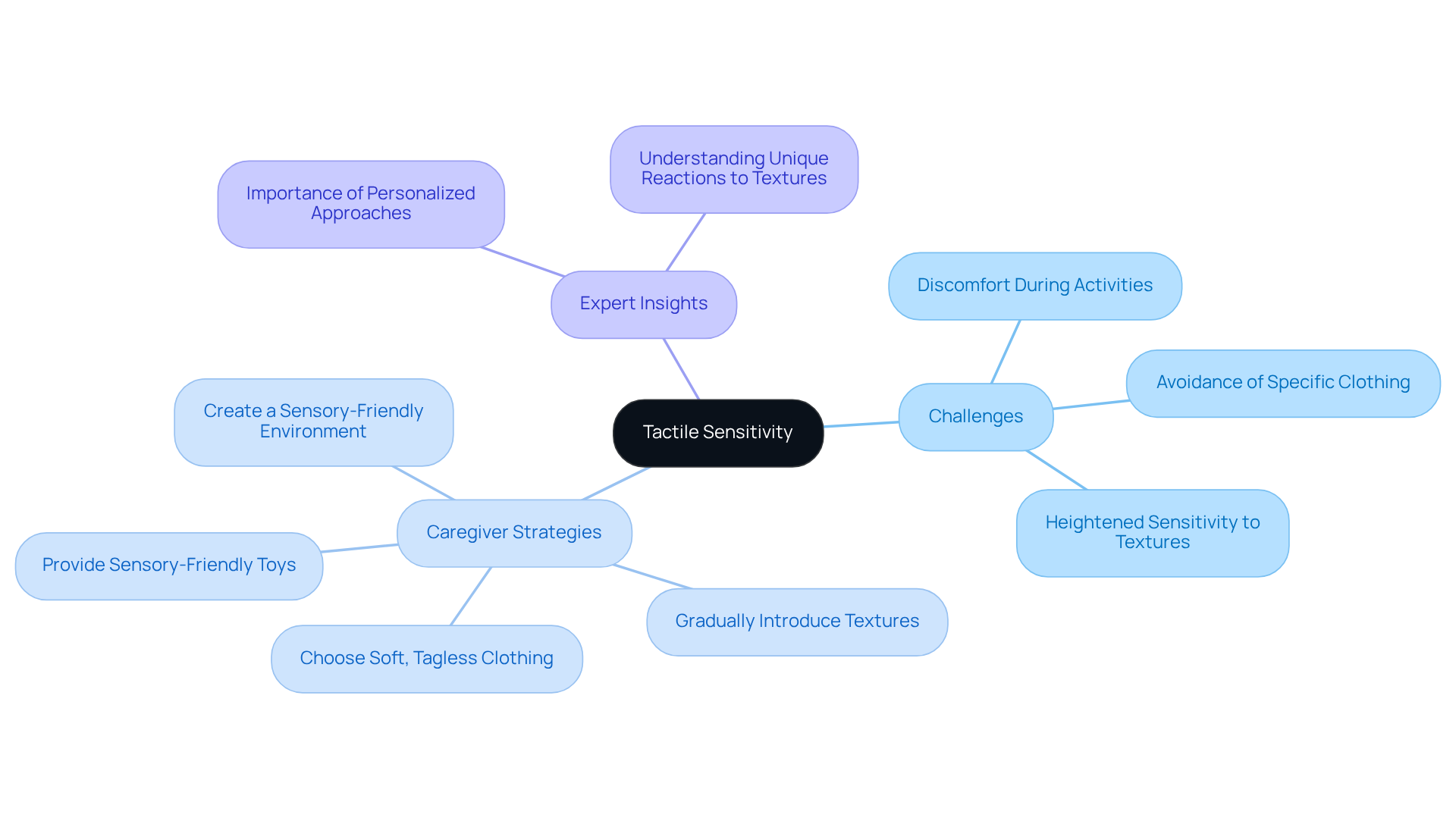
Olfactory Sensitivity: Reactions to Smells and Scents
Olfactory awareness can evoke strong responses in children with autism when they encounter various scents, such as perfumes, food, and cleaning products. These reactions can often lead to distress or avoidance behaviors, making it crucial for caregivers to identify and minimize exposure to examples of sensory issues, including triggering scents. Consider implementing strategies like using unscented products and creating a predictable environment that promotes safety and comfort.
Furthermore, encouraging young ones to express their preferences regarding scents can empower them and enhance communication. Recent studies shed light on the neurological underpinnings of these sensitivities, revealing that olfactory processing in children with the CNTNAP2 gene mutation may be affected. A study involving 18 individuals on the spectrum and 18 typically developing youths highlights these challenges, showing that those on the spectrum may struggle to filter out new background scents.
By understanding these dynamics, caregivers can better support their children in navigating their experiences, particularly those involving examples of sensory issues. The ongoing need for research into perceptual aspects related to autism spectrum disorder is vital for improving the quality of life for those affected. Together, we can foster environments that nurture and protect our children’s well-being.
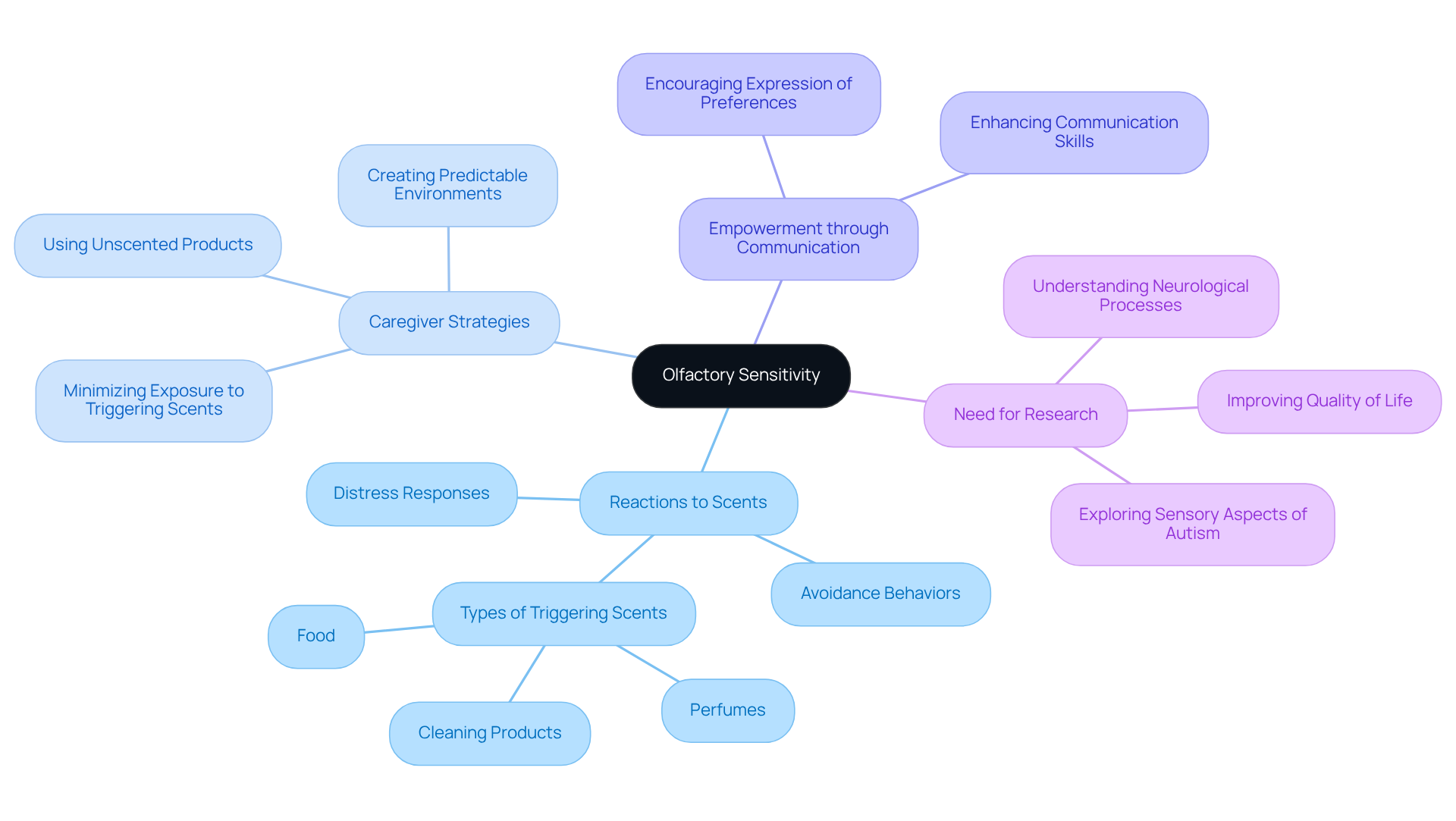
Proprioceptive Sensitivity: Awareness of Body Position and Movement
Proprioceptive sensitivity can profoundly affect a young person's body awareness, often leading to challenges with coordination and movement. It's important to recognize that around 95% of youngsters with autism have examples of sensory issues that affect how they experience their environment. This can lead to two very different responses: some may actively seek out vigorous physical activities like jumping and climbing, while others might shy away from such experiences due to examples of sensory issues.
To support these young individuals, caregivers can introduce a variety of activities designed to enhance body awareness and proprioceptive processing. For instance, engaging in resistance-based play—such as using weighted toys or navigating obstacle courses—can be especially beneficial. Moreover, incorporating regular sensory integration activities, like spinning and swinging, can improve proprioceptive input, ultimately fostering better coordination and movement skills.
As Kelly Beins, BHSc, OTR/L, insightfully notes, "Proprioceptive input plays a significant role as a regulator in the body, acting like a natural calming mechanism for an active nervous system." These activities not only promote physical development but also play a crucial role in emotional regulation and boosting self-confidence in young individuals with developmental disorders.
We encourage caregivers to explore these supportive activities and consider sharing their experiences in the comments or through newsletters. Together, we can foster a nurturing environment that empowers our children to thrive.
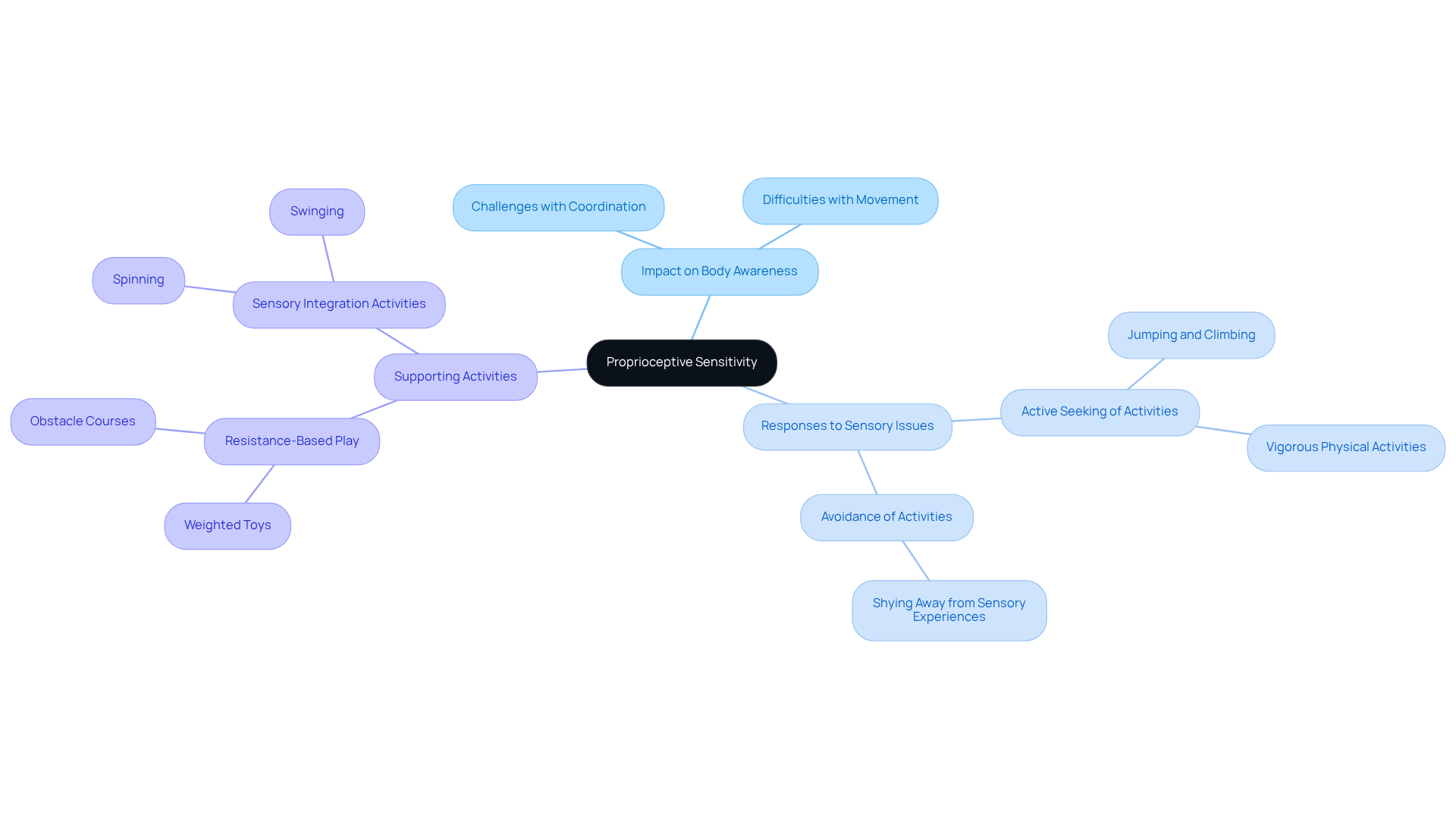
Vestibular Sensitivity: Impact on Balance and Spatial Orientation
Vestibular sensitivity plays a crucial role in a young person's balance and spatial orientation, often leading to difficulties with activities like riding a bike or navigating stairs. It's not uncommon for children to display contrasting behaviors; some may actively seek out movement, while others might shy away due to discomfort. Research reveals that about 35.84% of youths with balance complaints are diagnosed with vestibular issues, and 5.3% experience dizziness and balance challenges. This highlights the prevalence of these difficulties among individuals with autism.
As caregivers, you can make a significant difference by creating safe opportunities for movement. Consider activities such as:
- Swinging
- Spinning in a controlled environment
These can help desensitize vestibular responses and ultimately improve balance and spatial awareness. Additionally, incorporating sensory-friendly environments—like quiet rooms, dimly lit spaces, and areas with soft furnishings—can provide examples of sensory issues while further assisting in managing vestibular sensitivity, promoting a more comfortable experience for young individuals.
Temple Grandin once said, "Different, not less," reminding us of the unique experiences faced by young individuals with autism. By implementing these strategies, you can enhance your child's comfort and confidence as they navigate their world. What experiences have you encountered in supporting your child? Share your thoughts in the comments or through our newsletter, as your insights can foster a supportive community.
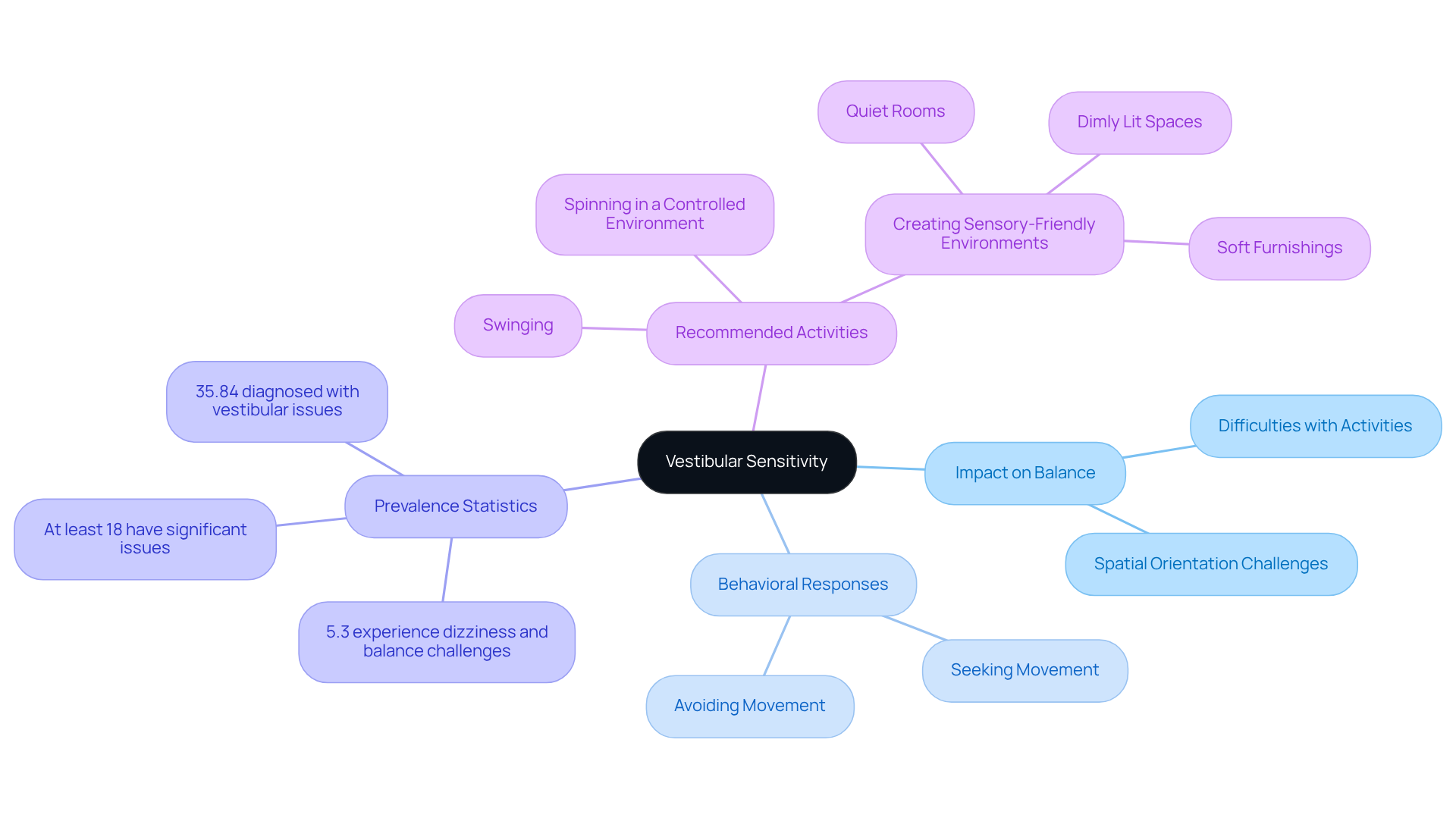
Sensory Overload: Understanding the Triggers and Responses
Overstimulation can be a challenging experience for young individuals, often leading to distress and potential meltdowns. Imagine a child overwhelmed by loud sounds, crowded places, or bright lights—these frequent triggers can easily disrupt their ability to process information. Recent estimates reveal that examples of sensory issues affect 69% to 93% of individuals with autism, highlighting the prevalence of this challenge in their lives.
As caregivers, your role is vital in recognizing these specific triggers and developing a tailored profile that meets each individual's unique needs. Effective management strategies can make a significant difference. Consider:
- Creating sensory-friendly environments
- Utilizing deep pressure techniques
- Providing quiet spaces for retreat
These approaches not only help alleviate sensory overload but also foster a supportive atmosphere that enhances well-being and reduces anxiety.
Jessica Stephens beautifully captures this sentiment: "There is no such thing as a 'bad kid' - just angry, hurt, tired, scared, confused, impulsive ones expressing their feelings & needs the only way they know how." Understanding and managing examples of sensory issues, including sensory overload, is crucial for improving the quality of life for young individuals with developmental disorders and their families. Together, we can work towards creating a more compassionate and accommodating environment for our children.
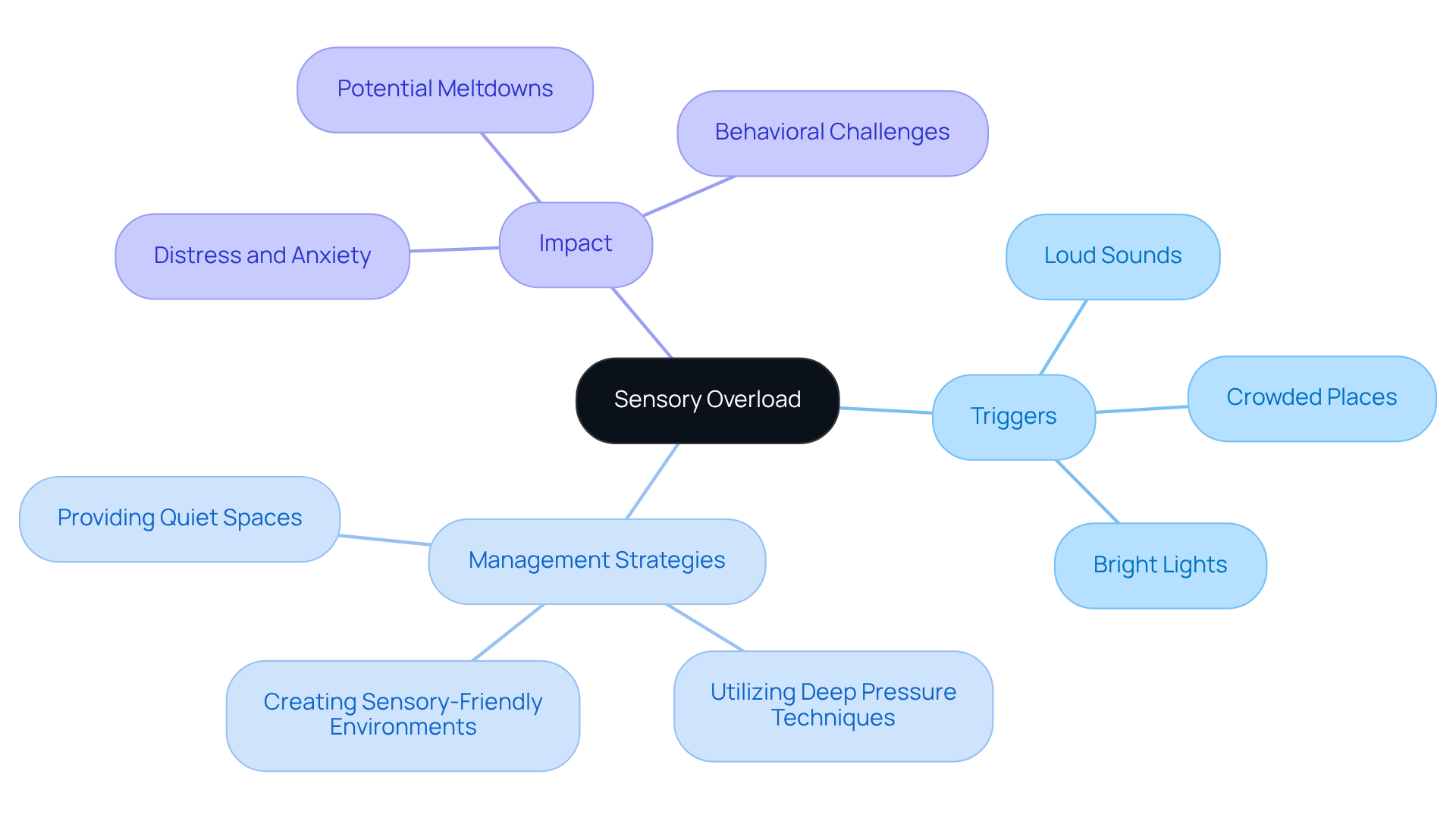
Creating Sensory-Friendly Environments: Strategies for Support
Creating sensory-friendly environments for youth with autism is a journey filled with effective strategies that address examples of sensory issues and can truly make a difference. Caregivers can begin this important process by minimizing noise levels and utilizing soft lighting, which together foster a calming atmosphere. Imagine a designated quiet area where children can retreat when feeling overwhelmed; this promotes their ability to self-regulate and find comfort in moments of stress.
Incorporating sensory tools, such as fidget toys and weighted blankets, can further assist children in managing their sensory experiences, which may include examples of sensory issues. These simple yet impactful additions can provide a sense of control and security. Establishing consistent routines and reliable schedules also plays a crucial role, as it helps young individuals navigate their environments with greater ease and confidence.
Recent studies have highlighted examples of sensory issues and the positive effects that sensory-friendly environments can have on youth behavior, demonstrating that thoughtful design can significantly enhance the well-being of children with developmental differences. With 3,967 individuals diagnosed with Autism Spectrum Disorder (ASD), the need for supportive environments is more pressing than ever.
As Traci Collins emphasizes, creating sensory-friendly healthcare settings is vital for better support of autistic individuals. This reflects a broader need for community awareness and support, reminding us all of the importance of fostering understanding and compassion in our surroundings. Together, we can create spaces that nurture and empower our children.
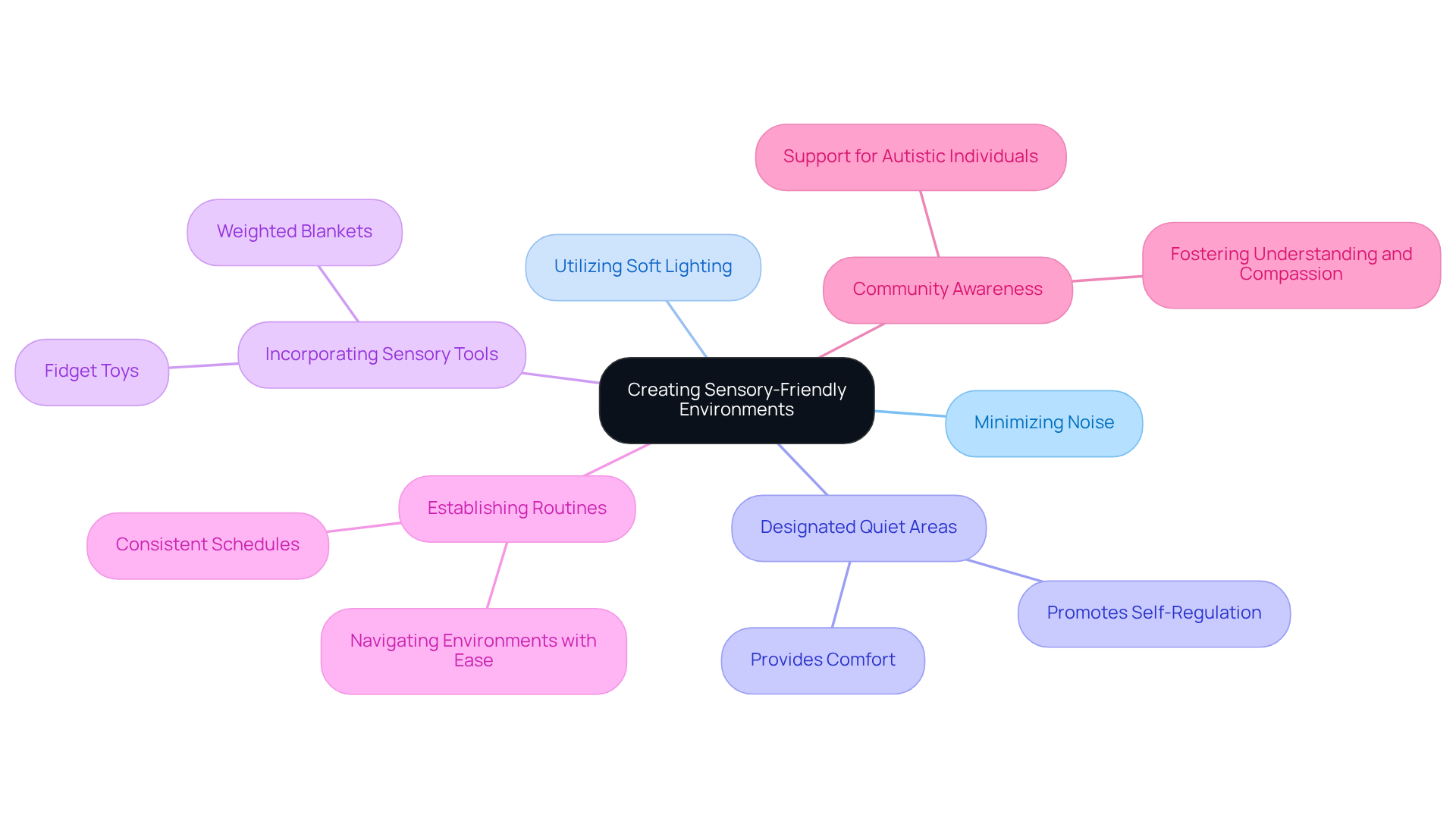
Implementing Sensory Breaks: Techniques for Managing Overstimulation
Sensory breaks are essential for helping individuals with autism manage overstimulation, which are examples of sensory issues, allowing them to reset and regain focus. As caregivers, you can effectively implement sensory breaks by incorporating a variety of techniques that resonate with your child's needs.
- Physical Activity: Engaging in movement-based activities like jumping jacks or wall push-ups can help children release pent-up energy and recalibrate their sensory processing.
- Quiet Time: Creating a tranquil setting for youngsters to relax can significantly lessen overwhelming stimuli. This may include dimming lights or using noise-canceling headphones.
- Calming Activities: Tasks like deep breathing exercises or playing with bins filled with textured materials can encourage relaxation and focus.
Establishing an organized schedule for breaks throughout the day enhances predictability, enabling young individuals to anticipate and manage their needs more effectively. Research suggests that brief breaks lasting 3-5 minutes are ideal after approximately 20-30 minutes of concentrated activity, helping to maintain attention and engagement.
Incorporating sensory-friendly tools, such as weighted blankets that provide deep pressure stimulation to calm the nervous system, or tactile toys like textured balls and vibrating toys that offer visual or auditory stimulation, can serve as examples of sensory issues while further supporting young individuals during these breaks. By tailoring sensory break techniques to individual needs and creating a sensory break schedule, you can cultivate a supportive environment that enhances focus and behavior in children with autism.

Conclusion
Understanding sensory issues in children with autism is vital for nurturing their growth and well-being. This article sheds light on various sensory sensitivities, including:
- Auditory
- Visual
- Tactile
- Olfactory
- Proprioceptive
- Vestibular
Each sensitivity can profoundly impact a child's daily life, often leading to distress in overwhelming environments. By recognizing these challenges, caregivers can implement tailored strategies that foster supportive spaces, addressing each child's unique needs.
Key insights emphasize the importance of proactive measures, such as:
- Creating quieter spaces
- Utilizing calming visuals
- Introducing sensory breaks
These strategies not only help manage sensory overload but also empower children to navigate their surroundings with increased confidence and comfort. The development of sensory-friendly environments is crucial, as it significantly enhances the quality of life for children with autism and their families.
Ultimately, fostering a deeper understanding of sensory issues is a collective endeavor that calls for the involvement of caregivers, educators, and the community. By sharing experiences and resources, we can cultivate a more compassionate and accommodating atmosphere, enabling children with autism to thrive. Embracing these strategies and insights can lead to meaningful improvements in the lives of those affected, ensuring they have the opportunity to flourish in a world that recognizes and supports their unique sensory experiences.
Frequently Asked Questions
What is ASD Media and what resources do they provide?
ASD Media is dedicated to enhancing the application of ABA therapy by offering a variety of resources aimed at addressing sensory issues faced by children with developmental conditions. They provide articles, guides, and community assistance to support parents and professionals.
How prevalent are sensory issues among individuals with autism spectrum disorder (ASD)?
Recent studies indicate that up to 90% of individuals with autism spectrum disorder experience sensory issues, including heightened sensitivity, which can significantly impact their participation in activities and overall growth.
Why is understanding sensory issues important for caregivers?
Understanding sensory issues is crucial as they can lead to maladaptive behaviors and hinder academic performance. By recognizing these challenges, caregivers can develop effective strategies to support their child's development and well-being.
What are some common challenges related to auditory sensitivity in children with autism?
Many children with autism experience discomfort or distress in loud environments, with approximately 90% showing some examples of sensory issues related to sound. This can lead to increased anxiety or meltdowns in response to loud noises.
What strategies can caregivers use to support children with auditory sensitivity?
Caregivers can create quieter spaces, use noise-canceling headphones, gradually expose children to various sounds, establish structured routines, and practice mindful techniques such as deep breathing or using comforting toys.
What is visual overstimulation and how does it affect children with sensory sensitivities?
Visual overstimulation occurs when children encounter bright lights, intricate patterns, or rapid movements, leading to difficulties in concentration and increased anxiety. Up to 70% of youngsters with developmental disorders face sensory issues related to visual overstimulation.
How can caregivers manage visual overstimulation for their children?
Caregivers can implement soft lighting, select simple visuals, offer sunglasses or tinted lenses in bright environments, and create a soothing atmosphere to help manage their children's visual sensitivities.
What is the significance of understanding the differences between autistic and non-autistic brains?
Understanding these differences can illuminate why individuals on the autism spectrum experience sensory overstimulation differently, ultimately enhancing their overall well-being and helping create supportive environments.




